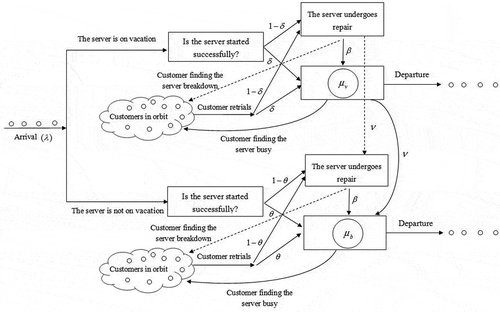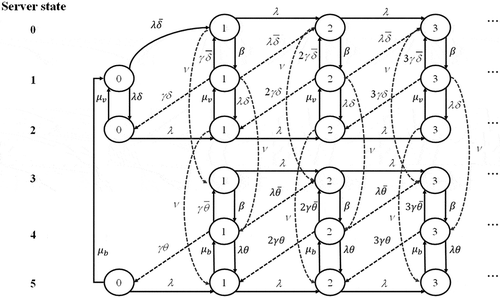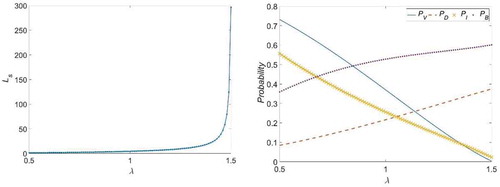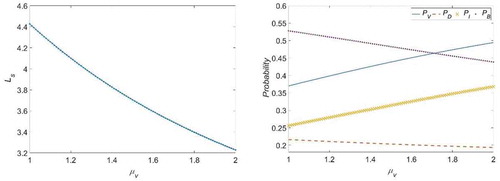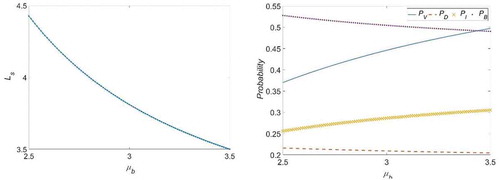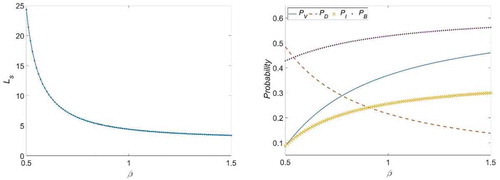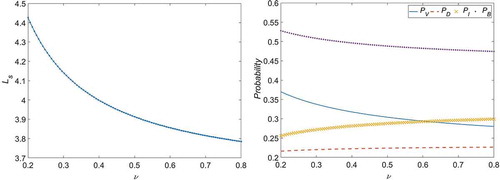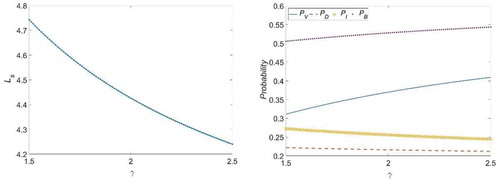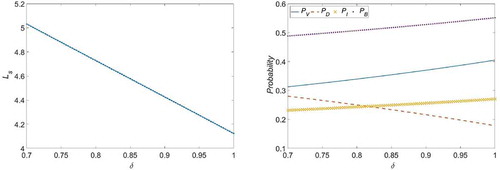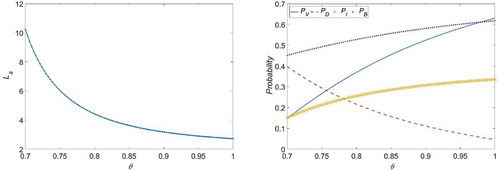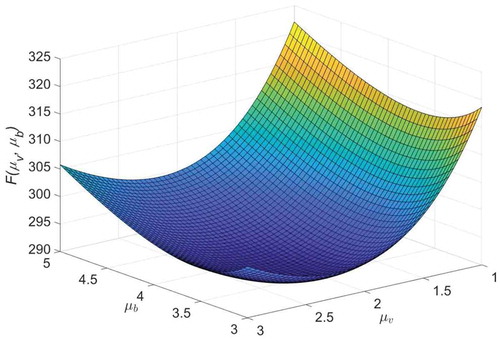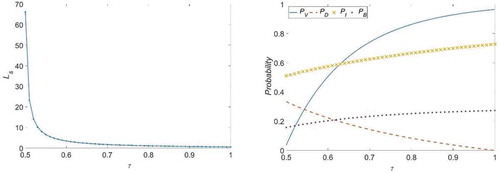 ?Mathematical formulae have been encoded as MathML and are displayed in this HTML version using MathJax in order to improve their display. Uncheck the box to turn MathJax off. This feature requires Javascript. Click on a formula to zoom.
?Mathematical formulae have been encoded as MathML and are displayed in this HTML version using MathJax in order to improve their display. Uncheck the box to turn MathJax off. This feature requires Javascript. Click on a formula to zoom.ABSTRACT
This paper presents a steady-state analysis of an M/M/1 retrial queue with working vacations, in which the server is subject to starting failures. The proposed queueing model is described in terms of the quasi-birth-death (QBD) process. We first derive the system stability condition. We then use the matrix-geometric method to compute the stationary probability distribution of the orbit size. Some performance measures for the system are developed. We construct a cost model, and our objective is to determine the optimal service rates during normal and vacation periods that minimize the expected cost per unit time. The canonical particle swarm optimization (CPSO) algorithm is employed to deal with the cost optimization problem. Numerical results are provided to illustrate the effects of system parameters on the performance measures and the optimal service rates. These results depict the system behaviour and show how the CPSO algorithm can be used to find numerical solutions for optimal service rates.
1. Introduction
In retrial queues with a single server, customers who find the server occupied upon arrival join the retrial group (orbit) to retry obtaining service after a random period of time. If the server is free when a customer arrives, then the customer is served immediately. Over the last two decades, intensive research has been conducted on retrial queues due to their wide applicability in telecommunication networks, communication systems, cellular mobile network, telephone switching systems, and computer networks. For a comprehensive survey on retrial queues, we refer the reader to two survey papers by Yang and Templeton [Citation1] and Shekhar et al. [Citation2]; three bibliographies of Artalejo [Citation3–Citation5]; and two books by Falin and Templeton [Citation6] and Artalejo and Gomez-Corral [Citation7].
In most of the literature on queueing systems, the server is assumed to be reliable (i.e., never fails). However, in the real world, servers are subject to breakdowns and/or repairs. When a breakdown occurs, service is interrupted until the failed server has been repaired. Retrial queues with server breakdowns have been addressed by many authors, including Sherman and Kharoufeh [Citation8], Falin [Citation9], Choudhury and Ke [Citation10], and Chang et al. [Citation11]. One important feature of retrial queues with server breakdowns is the issue of starting failure. Yang and Li [Citation12] described retrial queues with starting failures as follows: ‘If the server is idle, an arriving customer turns on the server in a negligible time. If the server is started successfully (with a certain probability), the customer gets service immediately. Otherwise, the server is sent to repair immediately, and the customer leaves the service area and repeats the request at a later time.’ They derived analytical results for the queue length distribution of M/G/1 retrial queues with starting failures, where it was assumed that retrial times are exponentially distributed. Kumar et al. [Citation13] subsequently investigated the M/G/1 retrial queue with starting failures and feedback, where it was assumed that retrial times are generally distributed. Wang and Zhao [Citation14] extended the work of Yang and Li [Citation12] to a discrete-time Geo/G/1 retrial queue with second optional service. Atencia et al. [Citation15] used the generating function technique to analyse a discrete-time Geo/G/1 retrial queue with general retrial times and Bernoulli feedback, in which the server is subject to starting failures. Wang and Zhou [Citation16] derived the steady-state probabilities for the M[X]/G/1 retrial queue with starting failures and Bernoulli feedback, where Bernoulli admission control was used for each individual customer. Multi-server retrial systems with starting failures were presented by Yang et al. [Citation17] and Ke et al. [Citation18].
In many real-world systems, the server becomes unavailable for a random amount of time (referred to as vacation time) immediately upon the departure of the last customer from the system. Vacation times can be used to perform tasks such as maintenance work or cleaning operations. The queueing systems with server vacations introduced by Levy and Yechiali [Citation19] are widely used in manufacturing systems, production systems, service systems, inventory systems, and other stochastic systems. The literature on vacation queueing models is extensive. Excellent surveys on this topic can be found in [Citation20–Citation23]. During such vacation periods, the server stops working completely; however, in many practical cases, the server continues working during vacation periods. This type of vacation policy (referred to as a working vacation) was introduced by Servi and Finn [Citation24] for the analysis of wavelength-division multiplexing optical access network using multiple wavelengths. Servi and Finn [Citation24] considered an M/M/1 queue with working vacations, wherein vacation times are exponentially distributed. Most of the earlier work on queueing models with working vacations can be found in the survey papers of Tian et al. [Citation25] and Chandrasekaran et al. [Citation26]. The M/M/1 retrial queue with working vacations was first studied by Do [Citation27], who derived closed-form solutions for the steady-state probabilities pertaining to the number of customers in the orbit. Li et al. [Citation28] and Liu and Song [Citation29] extended this work to discrete-time Geo/Geo/1 queues. Tao et al. [Citation30] generalized the model of Do [Citation27] to include vacation interruptions and collisions. Li et al. [Citation31] employed the probability generating function method to obtain the stationary probability distribution of M/M/1 retrial queues with working vacations and vacation interruption. Arivudainambi et al. [Citation32] used the method of supplementary variables to analyse the M/G/1 retrial queue with general retrial times and a single working vacation. Gao et al. [Citation33] used the same method to study the M/G/1 retrial queue with working vacations and vacation interruptions. Li et al. [Citation34] extended the model of Gao et al. [Citation33] to M/G/1 retrial queues with working vacations and vacation interruptions under Bernoulli scheduling, wherein arriving customers may balk (with a certain probability) upon finding that the server is busy. Recently, Do et al. [Citation35] investigated the equilibrium and socially optimal balking strategies of customers in M/M/1 retrial queues with working vacations.
In light of the practical applications of working vacations and service interruptions, this study focuses on retrial queues with working vacations and starting failures. Such a queueing model has potential applications in a health-care scenario. Rapid economic development and improving living standards have raised awareness of health-related matters and the demand for medical services. Some hospitals or clinics provide online consultation services to resolve the problem of long on-site queues. This allows patients to consult with a doctor without having to wait in line. Following this initial consultation, the patients may visit the hospital for further examination if necessary. Such consultation service also helps patients save time and money. We consider an online medical consultation service system, which operates via an APP running on a mobile device. A doctor is responsible for providing medical consultation services. Unfortunately, server disconnections or software bugs lead to inconsistencies in the provision of service (i.e., starting failure in queueing terminology). When no patients are waiting for online consultation service, the doctor is free to leave the system in order to perform other tasks, such as taking care of patients. While the doctor is absent from the system, a chatbot provides consultation services. After a period of time, the doctor returns to the online service to take over from the chatbot. Therefore, the proposed queueing model would be suitable for studying the above scenario.
The remainder of this paper is organized as follows. In Section 2, we present a description of the proposed model and the underlying assumptions. In Section 3, the stationary analysis of the M/M/1 retrial queue with working vacations and starting failures is presented in terms of the quasi-birth-death (QBD) process. We obtain the closed-form expression of the stability condition and use the matrix-geometric method to compute the steady-steady probability distribution. In Section 4, we develop the performance measures for the system. In Section 5, we deal with a cost optimization problem and provide numerical examples to illustrate the effects of parameters on optimal service rates. A special case and numerical comparisons are also presented. Conclusions are drawn in Section 6.
2. The model description and assumptions
In this paper, we consider an M/M/1 retrial queue with working vacations and starting failures, where arrivals follow a Poisson process with rate . We assume that new arrivals who find the server unavailable enter an orbit from which connection attempts are repeated until the requested service is completed. The intervals between successive connection attempts (retrials) are exponentially distributed with rate
when there are n customers in orbit. To make the analysis tractable, customers in orbit are permitted to conduct retrials up to
retrials. In other words, the retrial rate is
if the number of customers in orbit is n. The server leaves for a vacation at the instant the system becomes empty. Vacation times follow an exponential distribution with parameter
. During a vacation period, the server continues working at a lower level, rather than halting service entirely. If the system remains empty when a vacation ends, then the server takes another vacation. Service times during normal busy and vacation periods are exponentially distributed with parameters
and
(
), respectively.
In cases where the server is on vacation when an arrival occurs, the arrival triggers the server to switch on with probability . When the server is operating normally during busy periods, the probability that service will be commenced for a new or returning customer is
. If the server is successfully started, then the customer is served immediately. Otherwise, the server is sent for repairs, and the repair time follows an exponential distribution with parameter
. In the event that a server fails, the customer is moved into an orbit form which retrial requests are forwarded. The inter-arrival times, vacation times, service times during normal busy and vacation periods, and repair times are mutually independent. Henceforth, we refer to the above model as the M/M/1/WV retrial queue with starting failures. The general structure of the queueing model is illustrated in .
3. Stability condition and stationary distribution
Let be the number of customers in the orbit at time
, and
be the state of the server at time
, where
The M/M/1/WV retrial queue with starting failures can be modelled using a two-dimensional continuous-time Markov process with state space
. A Markov process is a QBD process when its one-step transitions from each state are restricted to states in the same level or in the two adjacent levels (see Van Leeuwaarden et al. [Citation36]). Thus, the stochastic process
is a QBD process. The state transition diagram is depicted in . Using the lexicographical sequence for the states, the infinitesimal generator
of the process has the block structure as follows:,
where
,
, and
are square matrices of order 6, given by
where
is a zero matrix of size
, and
is a
diagonal matrix with diagonal elements equal
.
3.1. Stability condition
We first study the stability condition of the system. To this end, let us define the invariant probability vector that satisfies
and
, where
is a zero row vector of length 6, and
denotes the identity column vector of order 6. Based on Theorem 3.1.1 in Neuts [Citation37], it follows that
. Then, the necessary and sufficient condition for the system to be stable is
Remark: If and
, the stability condition becomes
, which coincides with Do [Citation27].
3.2. Stationary distribution
If the stability condition is fulfiled, let be the stationary limit of the QBD process
. We define the steady-state probability vectors as
We denote the steady-state probability vector using , which satisfies the steady-state equations
and the normalization condition
, where
is a zero row vector and
is a column vector with ones. Based on Neuts [Citation37], the steady-state probability vector
takes the following geometric form:
where is the minimal nonnegative solution to the matrix-quadratic equation
and is a zero matrix of size
. The spectral radius of the matrix
is less than one if the stability condition is satisfied. We numerically compute matrix
using the iterative method. Starting with the initial value
, the following iteration is executed until the sum of the absolute value of all elements of the matrix is smaller than
, i.e.,
.
The steady-state equations can be written as
where represents a row vector of length 3, in which all elements are zero.
Since the determinant of the matrix is
, the matrix
is non-singular and its inverse exists. After some manipulations, Equations (5)–(7) become
where ,
, and
for
. Substituting Equations (10)–(12) into Equation (8) gives
The vector is determined by Equation (13) and the normalization condition
Then, the vectors (
,
) can be obtained using Equations (2) and (10)–(12).
4. Performance measures
Once the steady-state probability vector has been obtained, we are able to develop the following performance measures for the system.
The expected number of customers in the system
The expected number of customers in the orbit
The probability that the server is on vacation
The probability that the server undergoes repair
The probability that the server is idle and waits for newly arriving or retrial customers
The probability that the server is busy
In the following, we present numerical results illustrating the influence of various system parameters on some performance measures. The numerical results are computed using a PC with an Intel Core i5-7500 CPU and 16 GB RAM running R software (version 3.5.0). We fix and consider the following eight cases:
Case 1: ,
,
,
,
,
and
for various values of
.
Case 2: ,
,
,
,
,
and
for various values of
.
Case 3: ,
,
,
,
,
and
for various values of
.
Case 4: ,
,
,
,
,
and
for various values of
.
Case 5: ,
,
,
,
,
and
for various values of
.
Case 6: ,
,
,
,
,
and
for various values of
.
Case 7: ,
,
,
,
,
and
for various values of
.
Case 8: ,
,
,
,
,
and
for various values of
.
In each case, the selection of all system parameters fulfils the condition for stability. The behaviours of the performance measures for cases 1–8 are visualized in –, respectively. shows that increases with an increase in
. This may be due to the fact that any increase in the arrival rate would promote an increase in the number of customers who find the server unavailable (busy or failed) and are subsequently moved into the retrial orbit. Conversely, and show that
decreases as
or
increases. In –, we can see that the mean arrival rate (
) and the mean service rates (
and
) have counter effects on probabilities
,
,
, and
. We can see in that an increase in
leads to (i)
and
decrease, and (ii)
,
and
increase. This can be attributed to the fact that any increase in the repair rate would increase the probability of keeping the server available or operational. In , it is obvious that
,
and
decrease with an increase in the value of
. We can also see that
increases as
increases. shows that the larger is
, the smaller are
and
. Furthermore, any increase in
would lead to increases in
and
. Thus, it is reasonable that an increase in
would lead to an increase in the frequency with which customers make repeated attempts to access service. Moreover, and show that
is insensitive to change in
or
. and clearly show that (i)
and
decrease with an increase in
or
, and (ii)
,
and
increase as
or
increases. Based on the figures described above, we can conclude that the behaviour of the performance measures is generally in line with our expectations.
5. The cost model and optimization
We construct an expected cost function per unit time, in which the service rates and
are decision variables. We define the cost elements as follows:
holding cost per unit time per customer in the system;
cost per unit time when the server is on vacation;
cost per unit time when the server is busy;
cost per customer served under mean service rate
;
cost per customer served under mean service rate
.
Based on the above definitions of the cost elements and the corresponding performance measures of the system, the expected cost function per unit time can be derived as follows:
where ,
and
are obtained using Equations (15), (17) and (20), respectively. In Equation (21), the first term refers to the cost incurred by customers in the system, and the last four terms denote the costs incurred by the server. Our purpose is to determine the optimal service rates
by minimizing the expected cost function shown in Equation (21), where
represents the corresponding minimum value of the expected cost function; i.e.
. The expected cost function is complex and rigorous, making it difficult to derive explicit expressions for the optimal service rates. We, therefore, calculate numerical solutions.
5.1. Canonical particle swarm optimization algorithm
The particle swarm optimization (PSO) algorithm introduced by Kennedy and Eberhart [Citation38] is an efficient stochastic approach to optimizing continuous nonlinear functions. For more information on the PSO algorithm, readers are referred to [Citation39–Citation41]. In this study, we utilize the canonical particle swarm optimization (CPSO) algorithm presented by Carlisle and Dozier [Citation42] to obtain numerical results for . The CPSO algorithm has been widely used by several researchers to solve optimization problems in a variety of queueing systems ([Citation43–Citation47]). To approximate an optimal solution for
, we implement the following procedure based on the CPSO algorithm.
Step 1: Set , the population size
, the upper bound of the position value
, and the lower bound of the position value
.
Step 2: The initial positions and velocities of particles are randomly generated as follows: and
, where
.
Step 3: Assess the fitness values of each particle using the expected cost function in Equation (21); i.e., .
Step 4: The initial position of the particle i is set to the initial personal best position of the particle i (), and the initial global best position of all particles is set to
.
Step 5: Update the velocity of each particle using the following equation:
where and
. We generate random values for
and
in [0, 1]. Note that
is the constriction coefficient, and
is the sum of acceleration constants
and
; i.e.
. Moreover,
and
are set to 2.8 and 1.3, respectively.
Step 6: Update the position of each particle using the following equation:
Step 7: Update the personal best position of particle i () and the global best position of all particles
.
Step 8: Update the iteration counter .
Step 9: Stopping criterion: If is less than tolerance
, then the algorithm terminates; else return to Step 5.
Step 10: Output and
.
5.2. Numerical results
In the following, we present a numerical experiment to check the convexity of . The graphical representation of
is plotted in with the following parameter setting:
,
,
,
,
,
,
,
,
,
, and
. shows that
is convex with respect to service rates
and
; i.e. there exists a (local) minimum in the surface of the expected cost. We find the minimum expected cost using the CPSO algorithm to approximate the optimal values for
and
. We then explore the sensitivity of the approximate optimal service rates
with respect to various system parameters. In implementing the CPSO algorithm, we fix the upper and lower bounds of
and
at 0 and
, respectively. The population size is set to 500 (
), and the tolerance is set to 0.01 (
). The results are given in –, wherein CPU time represents the running time (in seconds) of the algorithm.
Table 1. Optimal service rates and the corresponding expected cost
for different values of
.
Table 2. Optimal service rates and the corresponding expected cost
for different values of
.
Table 3. Optimal service rates and the corresponding expected cost
for different values of
.
Table 4. Optimal service rates and the corresponding expected cost
for different values of
.
Table 5. Optimal service rates and the corresponding expected cost
for different values of
.
Table 6. Optimal service rates and the corresponding expected cost
for different values of
.
From , we can see that and
increase with an increase in
. This can be attributed to the fact that an increase in the arrival rate would increase the probability of congestion. An increase in the service rate would decrease the congestion of the system. From , it reveals that
decreases with an increase in the value of
. shows that
decreases and
increases as
increases. It is noted that
remains at 0 even when
is varied between 1.1 and 1.5. As shown in ,
increases and
decreases with an increase in
. In , one can see that an increase in
causes
to increase and
to decrease. We can see in that
decreases when
is varied from 0.55 to 0.9. Furthermore, increasing
leads to a decrease in
. As shown in –,
increases with an increase in the value of
and decreases with an increase in any one of the parameters
,
,
,
, or
. The results listed above demonstrate that system managers could optimize system costs by adjusting various system parameters. This observation provides a useful reference for decision-making.
5.3. A special case and numerical comparison
The model of Do [Citation27] is a special case of our model when (the server always starts successfully) and
(constant retrial policy). We set
and choose the system parameters as
,
,
,
, and
. The cost elements are identical to those used in Section 5.2. We select different values of
to compare the numerical results with Do [Citation27]’s model. Given the mean service rates
and
, shows that the effects of
on some performance measures. It reveals that
and
decrease as
increases. This is because that when
increases, the server is less prone to breakdowns, which leads to the smaller value of
and
. It is also found that
,
and
increase with an increase in
. shows the optimal service rates
and the corresponding expected cost
for different values of
. From , we observe that
increases and
decreases as
increases. Moreover, it is found that
decreases with increasing values of
. Therefore, we conclude that the probability
has an impact on the performance measures, the optimal service rates, and the minimum expected cost per unit time.
Table 7. Optimal service rates and the corresponding expected cost
for different values of
.
6. Conclusions
In this paper, we analysed the M/M/1/WV retrial queue with starting failures. The proposed queueing model was described by a QBD process. We first derived the stability conditions of the model. We then used the matrix-geometric method to obtain the stationary probability distribution and developed a number of performance measures. We formulated a cost optimization problem to determine the optimal service rates at the minimum expected cost per unit time. The CPSO algorithm was employed to obtain numerical solutions for
. We also examined the effects of various system parameters on performance measures and
through numerical experiments. In future works, the arrival process could be extended to the Markovian arrival process. Another direction would be to study the proposed queueing model within scenarios involving multiple servers.
Acknowledgments
The authors thank two anonymous referees for their valuable comments on this manuscript. This work was partially supported by the Ministry of Science and Technology, Taiwan, under Grant No. MOST 107-2218-E-009-058-MY2.
Disclosure statement
No potential conflict of interest was reported by the authors.
Additional information
Funding
References
- T. Yang and J.G.C. Templeton, A survey on retrial queues, Queueing Syst. 2 (1987), pp. 201–233. doi:10.1007/BF01158899
- C. Shekhar, A.A. Raina, and A. Kumar, A brief review on retrial queue: Progress in 2010–2015, Int. J. Appl. Sci. Eng. Res. 5 (2016), pp. 324–336. doi:10.6088/ijaser.05032
- J.R. Artalejo, A classified bibliography of research on retrial queues: Progress in 1990–1999, Top. 7 (1999), pp. 187–211. doi:10.1007/BF02564721
- J.R. Artalejo, Accessible bibliography on retrial queues, Math. Comput. Model. 30 (1999), pp. 1–6. doi:10.1016/j.mcm.2009.12.011
- J.R. Artalejo, Accessible bibliography on retrial queues: Progress in 2000–2009, Math. Comput. Model. 51 (2010), pp. 1071–1081. doi:10.1016/j.mcm.2009.12.011
- G.I. Falin and J.G.C. Templeton, Retrial Queues, Chapman and Hall, London, 1997.
- J.R. Artalejo and A. Gomez-Corral, Retrial Queueing Systems: A Computational Approach, Springer-Verlag, Berlin, Heidelberg, 2008.
- N.P. Sherman and J.P. Kharoufeh, An M/M/1 retrial queue with unreliable server, Oper. Res. Lett. 34 (2006), pp. 697–705. doi:10.1016/j.orl.2005.11.003
- G. Falin, An M/G/1 retrial queue with an unreliable server and general repair times, Perform. Eval. 67 (2010), pp. 569–582. doi:10.1016/j.peva.2010.01.007
- G. Choudhury and J.-C. Ke, An unreliable retrial queue with delaying repair and general retrial times under Bernoulli vacation schedule, Appl. Math. Comput. 230 (2014), pp. 436–450. doi:10.1016/j.amc.2013.12.108
- F.-M. Chang, T.-H. Liu, and J.-C. Ke, On an unreliable-server retrial queue with customer feedback and impatience, Appl. Math. Model. 55 (2018), pp. 171–182. doi:10.1016/j.apm.2017.10.025
- T. Yang and H. Li, The M/G/1 retrial queue with the server subject to starting failures, Queueing Syst. 16 (1994), pp. 83–96. doi:10.1007/BF01158950
- B.K. Kumar, S.P. Madheswari, and A. Vijayakumar, The M/G/1 retrial queue with feedback and starting failures, Appl. Math. Model. 26 (2002), pp. 1057–1075. doi:10.1016/S0307-904X(02)00061-6
- J. Wang and Q. Zhao, A discrete-time Geo/G/1 retrial queue with starting failures and second optional service, Comput. Math. Appl. 53 (2007), pp. 115–127. doi:10.1016/j.camwa.2006.10.024
- I. Atencia, I. Fortes, and S. Sánchez, A discrete-time retrial queueing system with starting failures, Bernoulli feedback and general retrial times, Comput. Ind. Eng. 57 (2009), pp. 1291–1299. doi:10.1016/j.cie.2009.06.011
- J. Wang and P.-F. Zhou, A batch arrival retrial queue with starting failures, feedback and admission control, J. Syst. Sci. Syst. Eng. 19 (2010), pp. 306–320. doi:10.1007/s11518-010-5140-z
- D.-Y. Yang, J.-C. Ke, and C.-H. Wu, The multi-server retrial system with Bernoulli feedback and starting failures, Int. J. Comput. Math. 92 (2015), pp. 954–969. doi:10.1080/00207160.2014.932908
- J.-C. Ke, T.-H. Liu, and D.-Y. Yang, Retrial queues with starting failure and service interruption, IET Commun. 12 (2018), pp. 1431–1437. doi:10.1049/iet-com.2017.0820
- Y. Levy and U. Yechiali, Utilization of idle time in an M/G/1 queueing system, Manage. Sci. 22 (1975), pp. 202–211. doi:10.1287/mnsc.22.2.202
- B.T. Doshi, Queueing systems with vacations—a survey, Queueing Syst. 1 (1986), pp. 29–66. doi:10.1007/BF01149327
- H. Takagi, Queueing Analysis: A Foundation of Performance Evaluation, Vol. 1, North-Holland, Amsterdam, 1991.
- N.-S. Tian and Z.G. Zhang, Vacation Queueing Models: Theory and Applications, Springer-Verlag, New York, 2006.
- J.-C. Ke, C.-H. Wu, and Z.-G. Zhang, Recent developments in vacation queueing models: a short survey, Int. J. Oper. Res. 7 (2010), pp. 3–8.
- L.D. Servi and S.G. Finn, M/M/1 queues with working vacations (M/M/1/WV), Perform. Eval. 50 (2002), pp. 41–52. doi:10.1016/S0166-5316(02)00057-3
- N.-S. Tian, J.-H. Li, and Z.G. Zhang, Matrix analytic method and working vacation queues—a survey, Int. J. Inf. Manage. Sci. 20 (2009), pp. 603–633.
- V.M. Chandrasekaran, K. Indhira, M.C. Saravanarajan, and P. Rajadurai, A survey on working vacation queueing models, Int. J. Pure Appl. Math. 106 (2016), pp. 33–41. doi:10.12732/ijpam.v106i6.5
- T.V. Do, M/M/1 retrial queue with working vacations, Acta Inform. 47 (2010), pp. 67–75. doi:10.1007/s00236-009-0110-y
- T. Li, Z. Wang, and Z. Liu, Geo/Geo/1 retrial queue with working vacations and vacation interruption, J. Appl. Math. Computing. 39 (2012), pp. 131–143. doi:10.1007/s12190-011-0516-x
- Z. Liu and Y. Song, Geo/Geo/1 retrial queue with non-persistent customers and working vacations, J. Appl. Math. Computing. 42 (2013), pp. 103–115. doi:10.1007/s12190-012-0623-3
- L. Tao, Z. Liu, and Z. Wang, M/M/1 retrial queue with collisions and working vacation interruption under N-policy, Rairo-Oper. Res. 46 (2012), pp. 355–371. doi:10.1051/ro/2012022
- T. Li, L. Zhang, and S. Gao, Performance of an M/M/1 retrial queue with working vacation interruption and classical retrial policy, Adv. Oper. Res. (2016), Article ID 4538031, PP. 9. doi:10.1155/2016/4538031.
- D. Arivudainambi, P. Godhandaraman, and P. Rajadurai, Performance analysis of a single server retrial queue with working vacation, Opsearch. 51 (2014), pp. 434–462. doi:10.1007/s12597-013-0154-1.
- S. Gao, J. Wang, and W.W. Li, An M/G/1 retrial queue with general retrial times, working vacations and vacation interruption, Asia Pac. J. Oper. Res. 31 (2014), pp. 25. doi:10.1142/S0217595914400065.
- T. Li, L. Zhang, and S. Gao, An M/G/1 retrial queue with balking customers and Bernoulli working vacation interruption, Qual. Technol. Quant. Manag. 16 (2019), pp. 511–530. doi:10.1080/16843703.2018.1480264
- N.H. Do, T.V. Do, and A. Melikov, Equilibrium customer behavior in the M/M/1 retrial queue with working vacations and a constant retrial rate, Oper. Res. Int. J. (2018). doi:10.1007/s12351-017-0369-7.
- J.S.H. Van Leeuwaarden, M.S. Squillante, and E.M.M. Winands, Quasi-birth-and-death processes, lattice path counting, and hypergeometric functions, J. Appl. Probab. 46 (2009), pp. 507–520. doi:10.1239/jap/1245676103
- M. Neuts, Matrix-Geometric Solutions in Stochastic Models, Johns Hopkins University Press, Baltimore, 1981.
- J. Kennedy and R. Eberhart, PSO optimization. In Proceedings of the IEEE international conference on Neural Networks, IEEE service center, Piscataway, NJ, pp. 1942–1948, 1995.
- Y. Shi and R. Eberhart, A modified particle swarm optimizer, In Proceedings of the IEEE International Conference on Evolutionary Computation, Anchorage, AK, USA, 1998, pp.69–73.
- J. Robinson and Y. Rahmat-Samii, Particle swarm optimization in electromagnetics, IEEE Trans. Antennas Propag. 52 (2004), pp. 397–407. doi:10.1109/TAP.2004.823969
- R. Poli, J. Kennedy, and T. Blackwell, Particle swarm optimization, Swarm Intell. 1 (2007), pp. 33–57. doi:10.1007/s11721-007-0002-0
- A. Carlisle and G. Dozier, An off-the-shelf PSO, In Proceeding of the workshop on particle swarm optimization, Purdue School of Engineering and Technology, Indianapolis, 2001.
- X. Zhang, J. Wang, and T.V. Do, Threshold properties of the M/M/1 queue under T-policy with applications, Appl. Math. Comput. 261 (2015), pp. 284–301. doi:10.1016/j.amc.2015.03.109
- X. Zhang, J. Wang, and Q. Ma, Optimal design for a retrial queueing system with state-dependent service rate, J. Syst. Sci. Complex. 30 (2017), pp. 883–900. doi:10.1007/s11424-017-5097-9
- Y. Zhang and J. Wang, Equilibrium pricing in an M/G/1 retrial queue with reserved idle time and setup time, Appl. Math. Model. 49 (2017), pp. 514–530. doi:10.1016/j.apm.2017.05.017
- J. Wang, X. Zhang, and P. Huang, Strategic behavior and social optimization in a constant retrial queue with the N-policy, Eur. J. Oper. Res. 256 (2017), pp. 841–849. doi:10.1016/j.ejor.2016.06.034
- K.-H. Wang, J. Wang, C.-D. Liou, and X. Zhang, Particle swarm optimization to the retrial machine repair problem with working breakdowns under the N policy, Queueing Mod, Serv. Manage 2 (2019), pp. 61–81.

